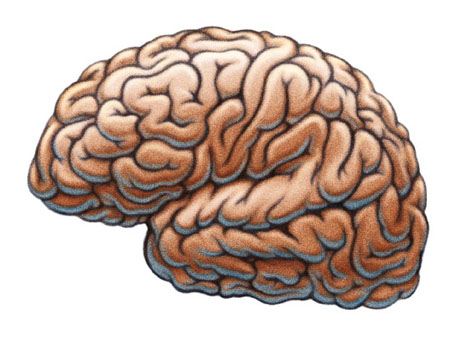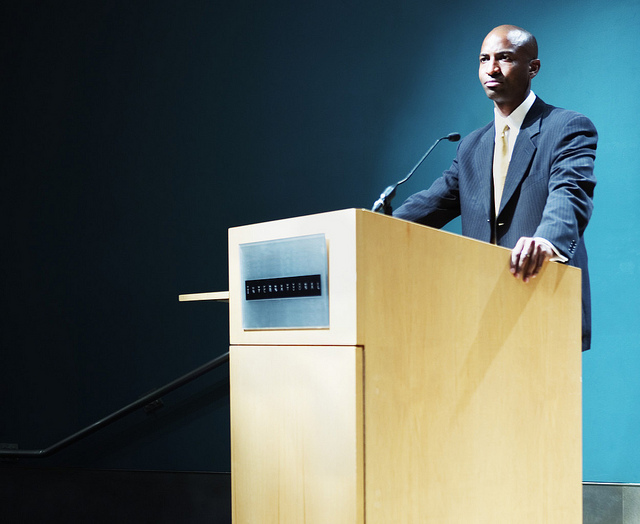3
Stand up, Speak out
Learning Objectives
- Explain the nature of communication apprehension.
- Distinguish among the four different types of communication apprehension.
- Identify various factors that cause communication apprehension.
- Explain steps for managing anxiety in speech preparation and delivery
- Describe strategies for stress reduction and dealing with unexpected events during a public speech
Battling Nerves and the Unexpected

One of your biggest concerns about public speaking might be how to deal with nervousness or unexpected events. If that’s the case, you’re not alone—fear of speaking in public consistently ranks at the top of lists of people’s common fears. Some people are not joking when they say they would rather die than stand up and speak in front of a live audience. The fear of public speaking ranks right up there with the fear of flying, death, and spiders (Wallechinsky, Wallace, & Wallace, 1977). Even if you are one of the fortunate few who don’t typically get nervous when speaking in public, it’s important to recognize things that can go wrong and be mentally prepared for them. On occasion, everyone misplaces speaking notes, has technical difficulties with a presentation aid, or gets distracted by an audience member. Speaking confidently involves knowing how to deal with these and other unexpected events while speaking.
In this chapter, we will help you gain knowledge about speaking confidently by exploring what communication apprehension is, examining the different types and causes of communication apprehension, suggesting strategies you can use to manage your fears of public speaking, and providing tactics you can use to deal with a variety of unexpected events you might encounter while speaking.
What Is Communication Apprehension?
“Speech is a mirror of the soul,” commented Publilius Syrus, a popular writer in 42 BCE (Bartlett, 1919). Other people come to know who we are through our words. Many different social situations, ranging from job interviews to dating to public speaking, can make us feel uncomfortable as we anticipate that we will be evaluated and judged by others. How well we communicate is intimately connected to our self-image, and the process of revealing ourselves to the evaluation of others can be threatening whether we are meeting new acquaintances, participating in group discussions, or speaking in front of an audience.
Definition of Communication Apprehension
According to James McCroskey, communication apprehension is the broad term that refers to an individual’s “fear or anxiety associated with either real or anticipated communication with another person or persons” (McCroskey, 2001). At its heart, communication apprehension is a psychological response to evaluation. This psychological response, however, quickly becomes physical as our body responds to the threat the mind perceives. Our bodies cannot distinguish between psychological and physical threats, so we react as though we were facing a Mack truck barreling in our direction. The body’s circulatory and adrenal systems shift into overdrive, preparing us to function at maximum physical efficiency—the “flight or fight” response (Sapolsky, 2004). Yet instead of running away or fighting, all we need to do is stand and talk. When it comes to communication apprehension, our physical responses are often not well adapted to the nature of the threat we face, as the excess energy created by our body can make it harder for us to be effective public speakers. But because communication apprehension is rooted in our minds, if we understand more about the nature of the body’s responses to stress, we can better develop mechanisms for managing the body’s misguided attempts to help us cope with our fear of social judgment.
Physiological Symptoms of Communication Apprehension

There are several physical sensations associated with communication apprehension. We might notice our heart pounding or our hands feeling clammy. We may break out in a sweat. We may have “stomach butterflies” or even feel nauseated. Our hands and legs might start to shake, or we may begin to pace nervously. Our voices may quiver, and we may have a “dry mouth” sensation that makes it difficult to articulate even simple words. Breathing becomes more rapid and, in extreme cases, we might feel dizzy or light-headed. Anxiety about communicating is profoundly disconcerting because we feel powerless to control our bodies. Furthermore, we may become so anxious that we fear we will forget our name, much less remember the main points of the speech we are about to deliver.
The physiological changes produced in the body at critical moments are designed to contribute to the efficient use of muscles and expand available energy. Circulation and breathing become more rapid so that additional oxygen can reach the muscles. Increased circulation causes us to sweat. Adrenaline rushes through our body, instructing the body to speed up its movements. If we stay immobile behind a lectern, this hormonal urge to speed up may produce shaking and trembling. Additionally, digestive processes are inhibited so we will not lapse into the relaxed, sleepy state that is typical after eating. Instead of feeling sleepy, we feel butterflies in the pit of our stomachs. By understanding what is happening to our bodies in response to the stress of public speaking, we can better cope with these reactions and channel them in constructive directions.
Any conscious emotional state such as anxiety or excitement consists of two components: a primary reaction of the central nervous system and an intellectual interpretation of these physiological responses. The physiological state we label as communication anxiety does not differ from the ones we label rage or excitement. Even experienced, effective speakers and performers experience some communication apprehension. What differs is the mental label that we put on the experience. Effective speakers have learned to channel their body’s reactions, using the energy released by these physiological reactions to create animation and stage presence.
Myths about Communication Apprehension

A wealth of conventional wisdom surrounds the discomfort of speaking anxiety, as it surrounds almost any phenomenon that makes us uncomfortable. Most of this “folk” knowledge misleads us, directing our attention away from effective strategies for thinking about and coping with anxiety reactions. Before we look in more detail at the types of communication apprehension, let’s dispel some of the myths about it.
- Only people bad at public speaking get anxious about it. As we have explained, speaking anxiety is a normal reaction. Good speakers can get nervous just as poor speakers do. Winston Churchill, for example, would get physically ill before major speeches in Parliament. Yet he rallied the British people in a time of crisis. Many people, even the most professional performers, experience anxiety about communicating. Such a widespread problem, Dr. Joyce Brothers contends, “cannot be attributed to deep-seated neuroses” (Brothers, 2008).
- Telling a joke or two is always a good way to begin a speech. Humor is some of the toughest material to deliver effectively because it requires an exquisite sense of timing. Nothing is worse than waiting for a laugh that does not come. Moreover, one person’s joke is another person’s slander. It is extremely easy to offend when using humor. The same material can play very differently with different audiences. For these reasons, it is not a good idea to start with a joke, particularly if it is not well related to your topic. Humor is just too unpredictable and difficult for many novice speakers. If you insist on using humor, make sure the “joke” is on you, not on someone else. Another tip is never to pause and wait for a laugh that may not come. If the audience catches the joke, fine. If not, you’re not left standing in awkward silence waiting for a reaction.
- Imagine the audience is naked. This tip just plain doesn’t work because imagining the audience naked will do nothing to calm your nerves. The audience is not some abstract image in your mind. It consists of real individuals with whom you can connect through your material. To “imagine” the audience is to misdirect your focus from the real people in front of you to an “imagined” group. What we imagine is usually more threatening than the reality that we face.
- Any mistake means that you have “blown it.” We all make mistakes. What matters is not whether we make a mistake but how well we recover. One of the authors of this book was giving a speech and wanted to thank a former student in the audience. Instead of saying “former student,” she said, “former friend.” After the audience stopped laughing, the speaker remarked, “Well, I guess she’ll be a former friend now!”—which got more laughter from the audience. A speech does not have to be perfect and, in fact, no speech is! You just have to make an effort to relate to the audience naturally and be willing to accept your mistakes.
- Avoid speaking anxiety by writing your speech out word for word and memorizing it. Memorizing your speech word for word will likely make your apprehension worse rather than better. Instead of remembering three to five main points and subpoints, you will try to commit to memory more than a thousand bits of data. If you forget a point, the only way to get back on track is to start from the beginning. You are inviting your mind to go blank by overloading it with details. In addition, audiences do not like to listen to “canned,” or memorized, material. Your delivery is likely to suffer if you memorize. Audiences appreciate speakers who talk naturally to them rather than recite a written script.
- Audiences are out to get you. With only a few exceptions the natural state of audiences is empathy, not antipathy. Most face-to-face audiences are interested in your material, not in your image. Watching someone anxious tends to make audience members anxious themselves. Particularly in public speaking classes, audiences want to see you succeed. They know that they will soon be in your shoes and they identify with you, most likely hoping you’ll succeed and give them ideas for how to make their own speeches better. If you establish direct eye contact with real individuals in your audience, you will see them respond to what you are saying, and this response lets you know that you are succeeding.
- You will look to the audience as nervous as you feel. Empirical research has shown that audiences do not perceive the level of nervousness that speakers report feeling (Clevenger, 1959). Most listeners judge speakers as less anxious than the speakers rate themselves. In other words, you feel much more nervous than you look and the audience likely has no idea! Some of the most effective speakers will return to their seats after their speech and exclaim they were so nervous. Listeners will respond, “You didn’t look nervous.” Audiences do not necessarily perceive our fears. Consequently, don’t apologize for your nerves. There is a good chance the audience will not notice if you do not point it out to them.
- A little nervousness helps you give a better speech. This “myth” is true! Professional speakers, actors, and other performers consistently rely on the heightened arousal of nervousness to channel extra energy into their performance. People would much rather listen to a speaker who is alert and enthusiastic than one who is relaxed to the point of boredom. Many professional speakers say that the day they stop feeling nervous is the day they should stop speaking in public. The goal is to control those nerves and channel them into your presentation.
Sources of Communication Apprehension
We have said that experiencing some form of anxiety is a normal part of the communication process. Most people are anxious about being evaluated by an audience. Interestingly, many people assume that their nervousness is an experience unique to them. They assume that other people do not feel anxious when confronting the threat of public speaking (McCroskey, 2001). Although anxiety is a widely shared response to the stress of public speaking, not all anxiety is the same. Many researchers have investigated the differences between apprehension grounded in personality characteristics and anxiety prompted by a particular situation at a particular time (Witt, et. al., 2006). McCroskey argues there are four types of communication apprehension: anxiety related to trait, context, audience, and situation (McCroskey, 2001). If you understand these different types of apprehension, you can gain insight into the varied communication factors that contribute to speaking anxiety.
Trait Anxiety
Some people are just more disposed to communication apprehension than others. As Witt, Brown, Roberts, Weisel, Sawyer, and Behnke explain, “Trait anxiety measures how people generally feel across situations and time periods” (Witt, et. al., 2006). This means that some people feel more uncomfortable than the average person regardless of the context, audience, or situation. It doesn’t matter whether you are raising your hand in a group discussion, talking with people you meet at a party, or giving speeches in a class, you’re likely to be uncomfortable in all these settings if you experience trait anxiety. While trait anxiety is not the same as shyness, those with high trait anxiety are more likely to avoid exposure to public speaking situations, so their nervousness might be compounded by lack of experience or skill (Witt, et. al., 2006). People who experience trait anxiety may never like public speaking, but through preparation and practice, they can learn to give effective public speeches when they need to do so.
Context Anxiety

Context anxiety refers to anxiety prompted by specific communication contexts. Some of the major contextual factors that can heighten this form of anxiety are formality, uncertainty, and novelty.
Formality
Some individuals can be perfectly composed when talking at a meeting or in a small group; yet when faced with a more formal public speaking setting, they become intimidated and nervous. As the formality of the communication context increases, the stakes are raised, sometimes prompting more apprehension. Certain communication contexts, such as a press conference or a courtroom, can make even the most confident individuals nervous. One reason is that these communication contexts presuppose an adversarial relationship between the speaker and some audience members.
Uncertainty
In addition, it is hard to predict and control the flow of information in such contexts, so the level of uncertainty is high. The feelings of context anxiety might be similar to those you experience on the first day of class with a new instructor: you don’t know what to expect, so you are more nervous than you might be later in the semester when you know the instructor and the class routine better.
Novelty
Additionally, most of us are not experienced in high-tension communication settings. The novelty of the communication context we encounter is another factor contributing to apprehension. Anxiety becomes more of an issue in communication environments that are new to us, even for those who are normally comfortable with speaking in public.
Most people can learn through practice to cope with their anxiety prompted by formal, uncertain, and novel communication contexts. Fortunately, most public speaking classroom contexts are not adversarial. The opportunities you have to practice giving speeches reduces the novelty and uncertainty of the public speaking context, enabling most students to learn how to cope with anxiety prompted by the communication context.
Audience Anxiety
For some individuals, it is not the communication context that prompts anxiety; it is the people in the audience they face. Audience anxiety describes communication apprehension prompted by specific audience characteristics. These characteristics include similarity, subordinate status, audience size, and familiarity.
You might have no difficulty talking to an audience of your peers in student government meetings, but an audience composed of parents and students on a campus visit might make you nervous because of the presence of parents in the audience. The degree of perceived similarity between you and your audience can influence your level of speech anxiety. We all prefer to talk to an audience that we believe shares our values more than to one that does not. The more dissimilar we are compared to our audience members, the more likely we are to be nervous. Studies have shown that subordinate status can also contribute to speaking anxiety (Witt, et. al., 2006). Talking in front of your boss or teacher may be intimidating, especially if you are being evaluated. The size of the audience can also play a role: the larger the audience, the more threatening it may seem. Finally, familiarity can be a factor. Some of us prefer talking to strangers rather than to people we know well. Others feel more nervous in front of an audience of friends and family because there is more pressure to perform well.
Situational Anxiety
Situational anxiety, McCroskey explains, is the communication apprehension created by “the unique combination of influences generated by audience, time and context” (McCroskey, 2001). Each communication event involves several dimensions: physical, temporal, social-psychological, and cultural. These dimensions combine to create a unique communication situation that is different from any previous communication event. The situation created by a given audience, in a given time, and in a given context can coalesce into situational anxiety.
Reducing Communication Apprehension

Experiencing some nervousness about public speaking is normal. The energy created by this physiological response can be functional if you harness it as a resource for more effective public speaking. In this section, we suggest several steps that you can take to channel your stage fright into excitement and animation. We will begin with specific speech-related considerations and then briefly examine some of the more general anxiety management options available.
Speech-Related Considerations
Communication apprehension does not necessarily remain constant throughout all the stages of speech preparation and delivery. One group of researchers studied the ebb and flow of anxiety levels at four stages in the delivery of a speech. They compared indicators of physiological stress at different milestones in the process:
- anticipation (the minute before starting the speech),
- confrontation (the first minute of the speech),
- adaptation (the last minute of the speech), and
- release (the minute immediately following the end of the speech) (Witt, et. al., 2006).
These researchers found that anxiety typically peaked at the anticipatory stage. In other words, we are likely to be most anxious right before we get up to speak. As we progress through our speech, our level of anxiety is likely to decline. Planning your speech to incorporate techniques for managing your nervousness at different times will help you decrease the overall level of stress you experience. We also offer a number of suggestions for managing your reactions while you are delivering your speech.
Think Positively
As we mentioned earlier, communication apprehension begins in the mind as a psychological response. This underscores the importance of a speaker’s psychological attitude toward speaking. To prepare yourself mentally for a successful speaking experience, we recommend using a technique called cognitive restructuring. Cognitive restructuring is simply changing how you label the physiological responses you will experience. Rather than thinking of public speaking as a dreaded obligation, make a conscious decision to consider it an exciting opportunity. The first audience member that you have to convince is yourself, by deliberately replacing negative thoughts with positive ones. If you say something to yourself often enough, you will gradually come to believe it.
We also suggest practicing what communication scholars Metcalfe, Beebe, and Beebe call positive self-talk rather than negative self-talk (Metcalfe, 1994; Beebe, 2000). If you find yourself thinking, “I’m going to forget everything when I get to the front of the room,” turn that negative message around to a positive one. Tell yourself, “I have notes to remind me what comes next, and the audience won’t know if I don’t cover everything in the order I planned.” The idea is to dispute your negative thoughts and replace them with positive ones, even if you think you are “conning” yourself. By monitoring how you talk about yourself, you can unlearn old patterns and change the ways you think about things that produce anxiety.
Reducing Anxiety through Preparation
As we have said earlier in this chapter, uncertainty makes for greater anxiety. Nothing is more frightening than facing the unknown. Although no one can see into the future and predict everything that will happen during a speech, every speaker can and should prepare so that the “unknowns” of the speech event are kept to a minimum. You can do this by gaining as much knowledge as possible about whom you will be addressing, what you will say, how you will say it, and where the speech will take place.
Analyze Your Audience
The audience that we imagine in our minds is almost always more threatening than the reality of the people sitting in front of us. The more information you have about the characteristics of your audience, the more you will be able to craft an effective message. Since your stage fright is likely to be at its highest at the beginning of your speech, it is helpful to open the speech with a technique to prompt an audience response. You might try posing a question, asking for a show of hands, or sharing a story that you know is relevant to your listeners’ experience. When you see the audience responding to you by nodding, smiling, or answering questions, you will have directed the focus of attention from yourself to the audience. Such responses indicate success; they are positively reinforcing, and thus reduce your nervousness.
Clearly Organize Your Ideas
Being prepared as a speaker means knowing the main points of your message so well that you can remember them even when you are feeling highly anxious, and the best way to learn those points is to create an outline for your speech. With a clear outline to follow, you will find it much easier to move from one point to the next without stumbling or getting lost.
A note of caution is in order: you do not want to react to the stress of speaking by writing and memorizing a manuscript. Your audience will usually be able to tell that you wrote your speech out verbatim, and they will tune out very quickly. You are setting yourself up for disaster if you try to memorize a written text because the pressure of having to remember all those particulars will be tremendous. Moreover, if you have a momentary memory lapse during a memorized speech, you may have a lot of trouble continuing without starting over at the beginning.
What you do want to prepare is a simple outline that reminds you of the progression of ideas in your speech. What is important is the order of your points, not the specifics of each sentence. It is perfectly fine if your speech varies in terms of specific language or examples each time you practice it.
It may be a good idea to reinforce this organization through visual aids. When it comes to managing anxiety, visual aids have the added benefit of taking attention off the speaker.
Adapt Your Language to the Oral Mode
Another reason not to write out your speech as a manuscript is that to speak effectively you want your language to be adapted to the oral, not the written, mode. You will find your speaking anxiety more manageable if you speak in the oral mode because it will help you to feel like you are having a conversation with friends rather than delivering a formal proclamation.
Appropriate oral style is more concrete and vivid than written style. Effective speaking relies on verbs rather than nouns, and the language is less complex. Long sentences may work well for novelists such as William Faulkner or James Joyce, where readers can go back and reread passages two, three, or even seven or eight times. Your listeners, though, cannot “rewind” you to catch ideas they miss the first time through.
Don’t be afraid to use personal pronouns freely, frequently saying “I” and “me”—or better yet, “us” and “we.” Personal pronouns are much more effective in speaking than language constructions, such as the following “this author,” because they help you to build a connection with your audience. Another oral technique is to build audience questions into your speech. Rhetorical questions, questions that do not require a verbal answer, invite the audience to participate with your material by thinking about the implications of the question and how it might be answered. If you are graphic and concrete in your language selection, your audience is more likely to listen attentively. You will be able to see the audience listening, and this feedback will help to reduce your anxiety.
Practice in Conditions Similar to Those You Will Face When Speaking
It is not enough to practice your speech silently in your head. To reduce anxiety and increase the likelihood of a successful performance, you need to practice out loud in a situation similar to the one you will face when actually performing your speech. Practice delivering your speech out loud while standing on your feet. If you make a mistake, do not stop to correct it but continue all the way through your speech; that is what you will have to do when you are in front of the audience.
If possible, practice in the actual room where you will be giving your speech. Not only will you have a better sense of what it will feel like to actually speak, but you may also have the chance to practice using presentation aids and potentially avoid distractions and glitches like incompatible computers, blown projector bulbs, or sunlight glaring in your eyes.
Two very useful tools for anxiety-reducing practice are a clock and a mirror. Use the clock to time your speech, being aware that most novice speakers speak too fast, not too slowly. By ensuring that you are within the time guidelines, you will eliminate the embarrassment of having to cut your remarks short because you’ve run out of time or of not having enough to say to fulfill the assignment. Use the mirror to gauge how well you are maintaining eye contact with your audience; it will allow you to check that you are looking up from your notes. It will also help you build the habit of using appropriate facial expressions to convey the emotions in your speech. While you might feel a little absurd practicing your speech out loud in front of a mirror, the practice that you do before your speech can make you much less anxious when it comes time to face the audience.
Reducing Nervousness during Delivery
Anticipate the Reactions of Your Body
There are several steps you can take to counteract the negative physiological effects of stress on the body. Deep breathing will help to counteract the effects of excess adrenaline. You can place symbols in your notes, like “slow down” or ☺, that remind you to pause and breathe during points in your speech. It is also a good idea to pause a moment before you get started to set an appropriate pace from the onset. Look at your audience and smile. It is a reflex for some of your audience members to smile back. Those smiles will reassure you that your audience members are friendly.
Physical movement helps to channel some of the excess energy that your body produces in response to anxiety. If at all possible, move around the front of the room rather than remaining imprisoned behind the lectern or gripping it for dear life (avoid pacing nervously from side to side, however). Move closer to the audience and then stop for a moment. If you are afraid that moving away from the lectern will reveal your shaking hands, use note cards rather than a sheet of paper for your outline. Notecards do not quiver like paper, and they provide you with something to do with your hands.
Vocal warm-ups are also important before speaking. Just as athletes warm up before practice or competition and musicians warm up before playing, speakers need to get their voices ready to speak. Talking with others before your speech or quietly humming to yourself can get your voice ready for your presentation. You can even sing or practice a bit of your speech out loud while you’re in the shower (just don’t wake the neighbors), where the warm, moist air is beneficial for your vocal mechanism. Gently yawning a few times is also an excellent way to stretch the key muscle groups involved in speaking.
Immediately before you speak, you can relax the muscles of your neck and shoulders, rolling your head gently from side to side. Allow your arms to hang down your sides and stretch out your shoulders.
Focus on the Audience, Not on Yourself
During your speech, make a point of establishing direct eye contact with your audience members. By looking at individuals, you establish a series of one-to-one contacts similar to interpersonal communication. An audience becomes much less threatening when you think of them not as an anonymous mass but as a collection of individuals. Speaking anxiety becomes more intense if you focus on yourself rather than concentrating on your audience and your material.
Stress Management Techniques
Even when we employ positive thinking and are well prepared, some of us still feel a great deal of anxiety about public speaking. When that is the case, it can be more helpful to use stress management than to try to make the anxiety go away.
One general technique for managing stress is positive visualization. Visualization is the process of seeing something in your mind’s eye. Frequently used in sports training, positive visualization involves using the imagination to create images of relaxation or ultimate success. Essentially, you imagine in great detail the goal for which you are striving, say, a rousing round of applause after you give your speech. You mentally picture yourself standing at the front of the room, delivering your introduction, moving through the body of your speech, highlighting your presentation aids, and sharing a memorable conclusion. If you imagine a positive outcome, your body will respond to it as though it were real. Such mind-body techniques create the psychological grounds for us to achieve the goals we have imagined. As we discussed earlier, communication apprehension has a psychological basis, so mind-body techniques such as visualization can be important to reducing anxiety. It’s important to keep in mind, though, that visualization does not mean you can skip practicing your speech out loud. Just as an athlete still needs to work out and practice the sport, you need to practice your speech to achieve the positive results you visualize.
Systematic desensitization is a behavioral modification technique that helps individuals overcome anxiety disorders. People with phobias, or irrational fears, tend to avoid the object of their fear. For example, people with a phobia of elevators avoid riding in elevators—and this only adds to their fear because they never “learn” that riding in elevators is usually perfectly safe. Systematic desensitization changes this avoidance pattern by gradually exposing the individual to the object of fear until it can be tolerated.
First, the individual is trained in specific muscle relaxation techniques. Next, the individual learns to respond with conscious relaxation even when confronted with the situation that previously caused them fear. James McCroskey used this technique to treat students who suffered from severe, trait-based communication apprehension (McCroskey, 1972). He found that “the technique was eighty to ninety percent effective” for the people who received the training (McCroskey, 2001). If you’re highly anxious about public speaking, you might begin a program of systematic desensitization by watching someone else give a speech. Once you can do this without discomfort, you would then move to talking about giving a speech yourself, practicing, and, eventually, delivering your speech.
The success of techniques such as these clearly indicates that increased exposure to public speaking reduces overall anxiety. Consequently, you should seek out opportunities to speak in public rather than avoid them. As the famous political orator William Jennings Bryan once noted, “The ability to speak effectively is an acquirement rather than a gift” (Carnegie, 1955).
Coping with the Unexpected

Even the most prepared, confident public speaker may encounter unexpected challenges during the speech. This section discusses some common unexpected events and addresses some general strategies for combating the unexpected when you encounter it in your own speaking.
Speech Content Issues
Nearly every experienced speaker has gotten to the middle of a presentation and realized that a key notecard is missing or that they skipped important information from the beginning of the speech. When encountering these difficulties, a good strategy is to pause for a moment to think through what you want to do next. Is it important to include the missing information, or can it be omitted without hurting the audience’s ability to understand the rest of your speech? If it needs to be included, do you want to add the information now, or will it fit better later in the speech? It is often difficult to remain silent when you encounter this situation, but pausing for a few seconds will help you to figure out what to do and may be less distracting to the audience than sputtering through a few “umms” and “uhs.”
Technical Difficulties
Technology has become a very useful aid in public speaking, allowing us to use audio or video clips, presentation software, or direct links to websites. However, one of the best-known truisms about technology is that it does break down. Web servers go offline, files will not download promptly, and media are incompatible with the computer in the presentation room. It is important to always have a backup plan, developed in advance, in case of technical difficulties with your presentation materials. As you develop your speech and visual aids, think through what you will do if you cannot show a particular graph or if your presentation slides are hopelessly garbled. Although your beautifully prepared chart may be superior to the oral description you can provide, your ability to provide a succinct oral description when technology fails can give your audience the information they need.
External Distractions
Although many public speaking instructors directly address audience etiquette during speeches, you’re still likely to encounter an audience member who walks in late, a ringing cell phone, or even a car alarm going off outside your classroom. If you are distracted by external events like these, it is often useful, and sometimes necessary (as in the case of the loud car alarm), to pause and wait so that you can regain the audience’s attention and be heard.
Whatever the unexpected event, your most important job as a speaker is to maintain your composure. It is important not to get upset or angry because of these types of glitches—and, once again, the key to this is being fully prepared. If you keep your cool and quickly implement a “plan B” for moving forward with your speech, your audience is likely to be impressed and may listen even more attentively to the rest of your presentation.
fear associated with giving a public speech
Trait anxiety measures how people feel in different contexts, some people feel more uncomfortable than the average person regardless of the context, audience, or situation.
anxiety prompted by specific communication contexts
communication apprehension prompted by specific audience characteristics including similarity, subordinate status, audience size, and familiarity.
communication apprehension created by “the unique combination of influences generated by audience, time and context” (McCroskey, 2001)
Changing how you label the physiological responses you will experience when experiencing communication apprehension
disputing your negative thoughts and replacing them with positive ones
Visualization is the process of seeing something in your mind’s eye, positive visualization is literally imagining and picturing yourself in a positive way
